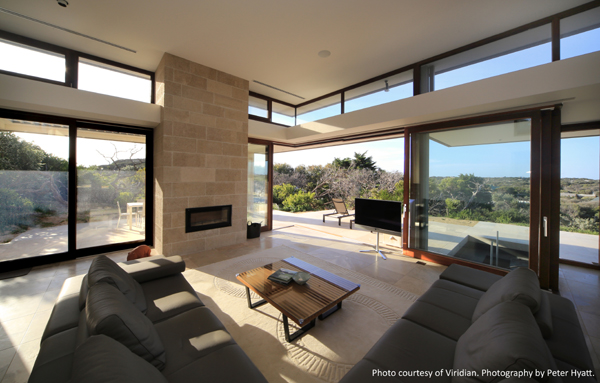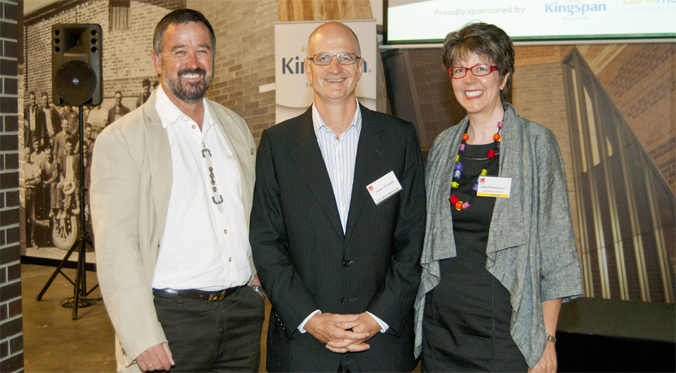Click here to view our latest blog

Grand Designs Australia - 5x4 Hayes Lane
Thursday, October 29, 2015
A small footprint, passive design, and sustainable products were the focal point when designing this home in inner city Melbourne. With dimensions of just 5 x 4 meters the Haynes Lane Project is an impressive example of what is possible when good design meets client focus and principles. Paarhammer Windows and doors are part of this project. We invite you to watch the show about this interesting building, airing on Foxtel on the 5 November at 8.30pm on 106 Lifestyle Channel. If you are unable to catch the airing of the episode at this time, 106 Lifestyle Channel is re-running
Liveability - add Value to your Home
Friday, September 25, 2015
Australia’s real estate agents are embracing the trend of comfort, energy efficiency, and healthy lifestyles when considering the appeal and marketability of a property. The use of the ‘Liveability Property Features’ icon when advertising a property indicates that the property includes a minimum of six recognised liveability features. The complete list of features are itemised in the ’17 Things’ checklist, which includes options such as orientation, insulation, energy rating, and water and energy efficiency devices. Windows and glazing is also an important component of the checklist. When selling your home, you will require independent proof of the products that are
Australian Made versus Imported Products
Tuesday, August 04, 2015
Paarhammer is proud to manufacture Australian Made windows and doors. Our philosophy is about sustainability and local jobs, therefore we use local materials where possible - including Australian glass - in our products. In the Paarhammer story, Australian Made translates to locally made windows and doors providing valuable training and skills sharing, and jobs not simply localised to the Paarhammer factory but extending to suppliers and manufacturers, including but not limited to, Australian glass manufacturers, and timber suppliers. However, with a flood of foreign products on the market it has never been more important to ensure that you are getting
Sustainability for End Users
Tuesday, July 14, 2015
Careful window selection and placement is rightly viewed as a means of reducing demand for artificial light and climate control. WERS – Window Energy Rating System - rates the energy impact of windows in housing anywhere in Australia. With up to 40% of a home’s energy for cooling or heating being lost or gained through windows, improving their thermal performance reduces energy costs and Australia’s greenhouse gas emissions. Windows and doors are rated as a whole, meaning glass and frame together. High performance glazing is a waste if the frames leak and create a draft. Equally important is sealing the
Sustainable Production
Monday, June 22, 2015
It is not enough to produce sustainable products from sustainable materials, the manufacturing process and facility have to fit in with the overall ideology at Paarhammer. When building the new factory in 2010 several sustainable features were included: Light Management: An automatic monitor dims lights or turns them off depending on natural light levels at each workplace. This results in better and constant light to work in for staff and reduced energy consumption. Water saving: Water from the large roof area is collected in huge water tanks and used to establish and water shade trees and ground covers around the
25 Year Paarhammer Anniversary
Wednesday, May 20, 2015
To mark the 25th anniversary celebration of Paarhammer, the staff spent a weekend taking in the sights and history of Echuca, including the iconic port. The staff trip was a great opportunity to unwind and mark the occasion. The dinner cruise on the Murray River was just one of many highlights. The Paarhammer story began in a small factory in Ballan in April 1990, with a staff of three, a philosophy for providing superior quality and creative timber solutions, and with the original name ‘Design and Handicraft Furniture’. However, the need for energy efficient European style windows and doors was
Do your Windows comply?
Tuesday, May 19, 2015
Recently some high profile projects were in the media for all the wrong reasons: their windows did not comply to the Australian Standard. The Australian Standards AS2047 and AS1288 set out minimum mandatory specifications under the Building Code of Australia which your windows and doors have to meet. All window manufacturers must comply with this Standard and must be able to verify compliance on request. The tests for AS2047 include a Deflection Test, Operating Force Test, Air Infiltration Test, Water Penetration Resistance Test and Ultimate Strength Test. All residential windows and doors must have a Performance Label that confirms the
Natural Light Equals Happy Homes
Sunday, January 18, 2015
Light in the home is more valued than ever before. We strive to take advantage of the building’s orientation for energy efficiency, to include views and invite nature into our homes, and to enjoy free flowing spaces for entertaining and our individual lifestyles. When asked what people’s aspirations were when building or renovating, the most common responses are: area, light, room, space, living – according to CSR Viridian Consumer Research. Renovation and real estate sites mention similar words: views, space, light, glass, natural, sun. The conclusion is ‘Natural Light/Space = Design Success and Market Appeal’. Coincidentally, research tells us that
Windows that insulate like Walls
Tuesday, October 07, 2014
Paarhammer windows are already known for their excellent insulation performance but a new glass technology brings this performance to a completely new level. Heat Mirror Glass is relatively unknown in the Australian market, but has been used for years overseas. For example, New York’s Empire State Building was refurbished in 2010, including the use of Heat Mirror glazing throughout – changes which were projected to save US$4.4M per year and 105,000 tonnes CO2 emission in 15 years. Heat Mirror (HM) insulating glass units (IGU) contain one or more clear, low-emissivity films suspended within the sealed airspace of a dual-pane IGU
What makes a Window a Good Window
Tuesday, September 30, 2014
At recent home shows this question was asked often, so I will try and answer it here: A good window consists of 5 parts: glazing, frame material, seals, locking points and installation Glass Double glazing is now quite common but it is important to consider the width of the air gap between the glass. Anything from 12 to 20mm is ideal as it is the air or gas which is between the two panes of glass which provides energy efficiency. Triple glazing should have two 12mm air gaps to increase the efficiency even more. Frame Look for a material which
10-Star Challenge
Friday, August 22, 2014
New houses in Australia have to meet 6 stars to comply with the Building Code. This requirement is quite easily reached. A movement for higher star ratings – and with it more energy efficient and comfortable buildings – is being undertaken by a number of architects and designers. The front runner is the BDAV (Building Designers Association of Victoria) which runs a 10-Star Challenge, giving Victoria’s building design fraternity the opportunity to design 10-Star energy efficient homes and be recognized for their design abilities and expertise in sustainable design responses. Already in its fourth year, the challenge is for conceptual
Policy Changes for NSW Rural Fire Service
Thursday, July 03, 2014
The newly released factsheet by the NSW Rural Fire Service (NSW RFS) details their policy changes in relation to modifications to existing buildings and developments in flame zone areas. Paarhammer fire resistant windows and doors, Australia’s only tested and approved to AS3959-2009 and AS1530.8.2, will now officially be considered. Based on community and industry feedback, the NSW RFS has reviewed its BAL-FZ policy in regards to alterations and additions to existing dwellings and the practical limitations associated with building to BAL-FZ. Applications for alterations and additions to existing residential dwellings where the outcome of the new works increases the level